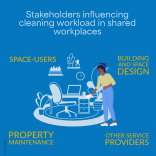Home › magazine › latest news › Cleaning workload in shared workplaces
Cleaning workload in shared workplaces
31st of March 2025For three years a team of industry experts has been gathering material on cleaning ergonomics and conscious cleaning. In the latest of their exclusive articles for ECJ, Helge Alt from Puhastusekspert in Estonia and Tarja Valkosalo of Propuhtaus Finland (who have been involved since the start) tackle the subject of cleaning workload in shared workplaces.
If you do an online image search with the words 'good ergonomics', you get pictures of a worker sitting at a desk. The images show how to ergonomically adjust the desk, chair and computer screen. This is useful information for the office worker, who can then adjust his or her workstation to make it as ergonomic as possible. But what is the ergonomics of cleaners' 'workstations'?
A cleaner's workstation changes several times a day, and the cleaner alone has no control over the ergonomics of the working environment. However, the working environment also has a significant impact on the cleaning workload. Factors affecting the physical stress of work include the condition of the premises and surface materials, furnishings, the cleanliness and tidiness of the premises, air conditioning and waste management.
Psychosocial stress can be caused, for example, by a lack of information on the use of the premises, which reduces the ability to plan one's own work which can cause a rush.
Improving the ergonomics of the working environment requires cooperation with various stakeholders in shared workplaces.
The basis for the cleaning workload is already established in the building and space planning. It would be important, for example, that it is possible to move cleaning machines from one floor to another without lifting, that there are no dust-collecting surfaces outside the reach, and that there are no surfaces that you need to clean in bent or awkward positions. Building and space planning is also important from a cleaning perspective, because many structural solutions in buildings are difficult to change afterwards.
The ease of cleaning the space is also very much influenced by the users of the space. According to our surveys made in Estonia, Finland, Hungary, and the Netherlands during the ErgoClean project, cleaners face many obstacles in their work. Seventy per cent of cleaners said that the amount of goods on floors and countertops made cleaning difficult. For example, cables snaking across the floor may require a bent working position to mop the floor. More than half of the respondents reported that abundant furniture and poor placement of furniture hampered cleaning. If dust removal is not effective, it can also have an impact on indoor air quality.
In Finland, efforts have been made to find a solution to this challenge and the so-called cleanability walks have been introduced. During these walks the customer and the cleaning company together examine whether there are any obstacles to cleaning and how they could be resolved. As a result of this collaboration, for example, wires on the floor have been lifted into wire racks and items on tables and on the top of cupboards have been moved into cabinets.
The survey results also highlighted that good cooperation with property management is needed to improve the working conditions of cleaners. For example, worn or damaged furniture or surfaces increase the workload of cleaners.
According to respondents, their employers are making efforts to improve safety and ergonomics in the workplace, but this alone is not enough. Cleaning is often an outsourced service, so cooperation with the client organisation and possibly other outsourced service providers is needed to improve safety and ergonomics.










